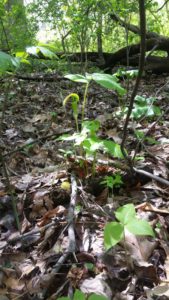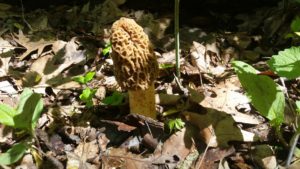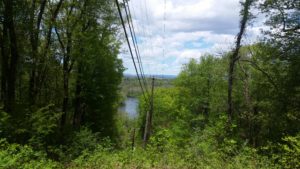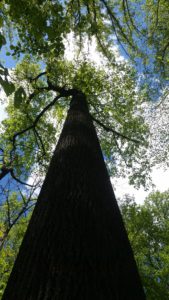We both had a free afternoon the weekend before last, the rain had stopped and the sun came out, and we were thinking of maybe doing a bike ride but the day seemed windy. So, we decided instead to go for a long, mushroom-hunting hike at an undisclosed location. Anne was hoping to find some morels, but since I can’t eat mushrooms I was just going along to look at the scenery and greenery…

It wasn’t very green, and this first piece of mushroom-related flora is not particularly edible (as far as I know) but its bright yellow color was very pleasing. I’m pretty sure it was a slime mold of some kind, which means it’s a symbiotic mix of fungus and algae, and it’s one of the few plants that can actually move. It seemed pretty immobile to us — maybe it was resting, or trying to hide, or maybe it really was chewing gum.
I think of slime mold as a “processing” plant, turning other dead plants back into soil, and we saw a bunch of them in various places, working away. I took it as a good indicator that there were so many signs of vegetation decay, even to where you could smell it — every so often you’d get a whiff of composting or whatever, along with a slightly warmer puff of breeze. The detritus on the forest floor was definitely being processed. The rainy weather was probably a good thing for all those micro critters, and so maybe it would also be a good thing for regular mushrooms.

The rain had also driven the green-up, which in this unusually cold spring seemed slower in coming, into overdrive, and there were many plants and flowers in bloom that were not around just a week earlier, especially along the forest floor. (Granted, we were looking down a lot more than I usually do, so I could have been noticing more at ankle level than I usually would. Also, I was with Anne, who has a greater affinity and appreciation — and eye — for these plants than I do, and knows all their names.)
Anne really likes Jack-in-the-pulpits, and she spotted this one early on, as well as many more hidden under the taller plants. Some were a little farther along in blossoming than others, some had slightly different colors or patterns; it was strange to see how much they varied one from another, even as they seemed identical from even a short distance. I took photos of the first several –“ooh! there’s another one, and so different from that last one!”– before I got Jack-in-the-pulpit burnout, so I’ll stick with just this one photo, which I think was a pretty good representation of our discoveries.

Pay dirt! We really weren’t too far along into our hike when we saw this beauty. No one really knows what morels like or don’t like, but they do seem to appear on hilly slopes, on sunny spring days just after rain, so we had our hopes up, and here was confirmation.
Unfortunately, this was the only one we saw in 12 miles of searching.

Not long after our single morel discovery, we came to the first cut through the woods, which I think is an old telephone line. I took the picture deliberately in this direction not just because this view was so pretty, but because, behind me as I took this, was where the power company had been refurbishing their own lines — bulldozers, gravel, a huge, mile-long scar maybe a hundred yards across…
Anyway, in his view you can see the Lehigh River through the trees; in the background is the Lehigh Valley, with Blue Mountain at the horizon. A few more steps and we were back in the woods, and back to looking down at the ground…

If you can see the ground! The may-apples are usually among the first things up, and they can get pretty dense. They form a knee-high simulacrum of the tree canopy above us, a mini-canopy which hides the world just below. Up until a few years ago I didn’t know that may-apples even had blossoms, since they form about midway up the stalk, hidden under the mini-canopy, which is a shame because they actually are very pretty flowers. Here I stuck my camera through the leaves and close to the ground, and got a nice close-up two of them.

There were other places where the may-apples didn’t grow as thick, and you could see individual plants without too much trouble. Here’s one with its upper leaf and its blossom.
Underneath the may-apple, you can see a bunch of even smaller plants, forming yet another canopy on an even smaller scale. In many places these plants — violets, garlic mustard — were very thick on the ground, the main plants in that area, and formed an almost velvety-looking ground cover.

Here are a few of the smaller plants, a regular violet and maybe some white violets, spread out and a little more isolated from any others. There were all sorts of little flowering plants everywhere you looked, these were just a small sample.

With all that looking down, I think ‘ll add one shot looking up at the real canopy. I’m not sure what this tree is, but there were many like it here and there, and they were impressively tall, with long straight trunks before you got to the first limbs. Maybe this is what it looks like to a bug under the violets, or a chipmunk under the may-apples.
We were on our way back at this point, and getting a little tired and sore — when we got home we realized we’d walked about 12 or 13 miles. A nice little walk in the woods!
